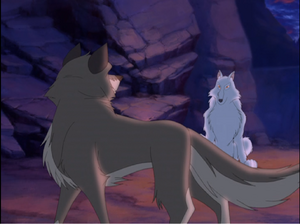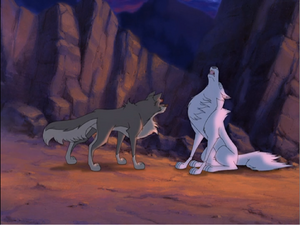No edit summary Tag: sourceedit |
No edit summary Tag: Source edit |
||
| (36 intermediate revisions by 21 users not shown) | |||
| Line 1: | Line 1: | ||
| − | {{Infobox |
+ | {{Hero Infobox |
| + | |image = Aniu.png |
||
| − | |Box title = Heroine |
||
| − | | |
+ | |fullname = Aniu |
| + | |alias = White Wolf |
||
| ⚫ | |||
| ⚫ | |||
| − | |Row 1 title = Full Name |
||
| + | |skills = Possibly her wolf genes<br> |
||
| − | |Row 1 info = Aniu |
||
| + | Magic/Spiritual powers |
||
| − | |Row 2 title = Alias |
||
| + | |family = Unnamed Mate<br>[[Balto]] (son)<br>[[Jenna (Balto)|Jenna]] (daughter-in-law)<br>[[Aleu]], [[Saba]] (granddaughters)<br>[[Kodi]], [[Dingo]] (grandsons)<br>Two unnamed grandchildren |
||
| − | |Row 3 title = Origin |
||
| + | |type of hero = Animal Spirit Guide |
||
| ⚫ | |||
| ⚫ | |||
| − | |Row 4 title = Occupation |
||
| − | | |
+ | |occupation=Balto's mom and spirit guide}} |
| + | {{Quote|Only the journey home, my son.|To Balto}} |
||
| − | |Row 5 title = Powers / Skills |
||
| ⚫ | |||
| − | |Row 6 title = Hobbies |
||
| − | |Row 7 title = Goals |
||
| − | |Row 8 title = Type of Heroine |
||
| ⚫ | |||
| + | She was voiced by Monnae Michaell. |
||
==Role in the Balto films== |
==Role in the Balto films== |
||
===Balto=== |
===Balto=== |
||
| Line 21: | Line 19: | ||
===Balto II: Wolf Quest=== |
===Balto II: Wolf Quest=== |
||
| − | + | It becomes much more evident in the second film that Aniu is indeed a spirit and not a living wolf. She is known to have taken two forms along the way to help both Balto and [[Aleu]]: Wolf (Spirit, Guide, Lead, Conduct), her true self, the teacher. Raven (Dreams, Visions, and Nightmares), the dark bird that appeared in Balto's dreams. These forms could possibly allude to the Raven and Wolf/Eagle moieties of the Tlingit people of Southeast Alaska, and the portrayal of both moieties (also known as 'descent groups') through the same character could symbolize Balto and Aleu's mixed heritages. It has also been suggested (although not confirmed) that she took various other forms, namely: Fox (Cunning trickster). Wolverine (Fears). Bear (Inner Knowing). Caribou (Life). These animals matched up to those on a totem pole (suggesting that the story in the film may be influenced by Native American folklore) that Balto occasionally passed by. In a dream vision of Balto's, she explained the meaning of each totem animal to him. The pack of wolves that Aleu and Balto meet refer to Aniu as a legendary figure. At the very end of the film, Aniu is revealed to be Balto's spirit guide and mother. |
|
| + | |||
| + | ==Gallery== |
||
| + | <gallery widths="300" position="center" captiontextcolor="#8e8e8e" bordercolor="#8e8e8e"> |
||
| + | Balto's heroic wolf howl.jpg|The spirit of Aniu encourages Balto to bring the medicine to Safety. |
||
| + | Balto and his mother.png |
||
| + | Balto and his mother2.png |
||
| + | </gallery> |
||
==Trivia== |
==Trivia== |
||
*Aniu means "snow" in Inuit. |
*Aniu means "snow" in Inuit. |
||
*Some fans still dispute as to whether or not Aniu and the white wolf from the first film are the same wolf, even though director of Wolf Quest, Phil Weinstein, declared in an interview that they are in fact the same wolf. |
*Some fans still dispute as to whether or not Aniu and the white wolf from the first film are the same wolf, even though director of Wolf Quest, Phil Weinstein, declared in an interview that they are in fact the same wolf. |
||
| + | *In the Junior Novel, the White Wolf is refered as a "he" |
||
| + | *During an interview with Simon Wells (Director of Balto not the sequels), a question was ask to him about the White Wolf/Aniu's appearance and Simon's reply: |
||
| + | "Whether the White Wolf is Balto's father or some kind of ephemeral Spirit of the Wolf is deliberately unstated. The White Wolf Sequence is still my favorite part of the movie, and James Horner's extraordinary score that accompanies it still raises the hairs on the back of my neck. |
||
| + | |||
| + | We wanted to keep it mystical and vague - is this a real event or is it some kind of hallucination that Balto is experiencing? All of these were reasons to not have the White Wolf speak or in any way explain himself. Perhaps the Wolf is a manifestation of Balto's inner voice, telling him to take ownership and use that part of him that he has always been ashamed of - certainly that is the message Balto takes from the encounter, real or not. |
||
| + | |||
| + | (And by the way, if it was really his dad why didn't the old man help him drag the antitoxin up the cliff?)" |
||
| + | |||
| + | The sequels made the White Wolf to be Balto's mother which is completely false as Simon Wells stated that Balto's wolf side came from his dad." |
||
[[Category:Movie Heroes]] |
[[Category:Movie Heroes]] |
||
[[Category:Cartoon Heroes]] |
[[Category:Cartoon Heroes]] |
||
| − | [[Category: |
+ | [[Category:Animals]] |
| − | [[Category: |
+ | [[Category:Female]] |
| ⚫ | |||
[[Category:Parents]] |
[[Category:Parents]] |
||
| − | [[Category:Deceased |
+ | [[Category:Deceased]] |
| − | [[Category: |
+ | [[Category:Noncorporeal]] |
| − | [[Category: |
+ | [[Category:Paranormal]] |
| − | [[Category: |
+ | [[Category:Predators]] |
| ⚫ | |||
[[Category:Pacifists]] |
[[Category:Pacifists]] |
||
| ⚫ | |||
| ⚫ | |||
| ⚫ | |||
[[Category:Bigger Good]] |
[[Category:Bigger Good]] |
||
| − | [[Category: |
+ | [[Category:Benevolent Rulers]] |
| − | [[Category: |
+ | [[Category:Martyr]] |
| ⚫ | |||
| ⚫ | |||
| ⚫ | |||
| ⚫ | |||
| ⚫ | |||
Revision as of 03:49, 3 March 2022
| “ | Only the journey home, my son. | „ |
| ~ To Balto |
Aniu is the posthumous overarching protagonist of Universal Studios' 1995 animated film Balto and its straight-to-video sequel, Balto II: Wolf Quest. She is Balto's deceased mother who serves as a spirit guide in the Balto series.
She was voiced by Monnae Michaell.
Role in the Balto films
Balto
Aniu played a very significant role in the first film, although only appearing twice to remind Balto of his wolf heritage; she is still part of one of the most powerful and emotional scenes in the movie. She is never mentioned by name, nor does she speak throughout the film, and appears to only be a mysterious figure who comes to Balto in his times of need to give him spiritual support and encouragement. It is hinted that Aniu may be a spirit guide instead of a living wolf, though this is never directly made clear.
Balto II: Wolf Quest
It becomes much more evident in the second film that Aniu is indeed a spirit and not a living wolf. She is known to have taken two forms along the way to help both Balto and Aleu: Wolf (Spirit, Guide, Lead, Conduct), her true self, the teacher. Raven (Dreams, Visions, and Nightmares), the dark bird that appeared in Balto's dreams. These forms could possibly allude to the Raven and Wolf/Eagle moieties of the Tlingit people of Southeast Alaska, and the portrayal of both moieties (also known as 'descent groups') through the same character could symbolize Balto and Aleu's mixed heritages. It has also been suggested (although not confirmed) that she took various other forms, namely: Fox (Cunning trickster). Wolverine (Fears). Bear (Inner Knowing). Caribou (Life). These animals matched up to those on a totem pole (suggesting that the story in the film may be influenced by Native American folklore) that Balto occasionally passed by. In a dream vision of Balto's, she explained the meaning of each totem animal to him. The pack of wolves that Aleu and Balto meet refer to Aniu as a legendary figure. At the very end of the film, Aniu is revealed to be Balto's spirit guide and mother.
Gallery
Trivia
- Aniu means "snow" in Inuit.
- Some fans still dispute as to whether or not Aniu and the white wolf from the first film are the same wolf, even though director of Wolf Quest, Phil Weinstein, declared in an interview that they are in fact the same wolf.
- In the Junior Novel, the White Wolf is refered as a "he"
- During an interview with Simon Wells (Director of Balto not the sequels), a question was ask to him about the White Wolf/Aniu's appearance and Simon's reply:
"Whether the White Wolf is Balto's father or some kind of ephemeral Spirit of the Wolf is deliberately unstated. The White Wolf Sequence is still my favorite part of the movie, and James Horner's extraordinary score that accompanies it still raises the hairs on the back of my neck.
We wanted to keep it mystical and vague - is this a real event or is it some kind of hallucination that Balto is experiencing? All of these were reasons to not have the White Wolf speak or in any way explain himself. Perhaps the Wolf is a manifestation of Balto's inner voice, telling him to take ownership and use that part of him that he has always been ashamed of - certainly that is the message Balto takes from the encounter, real or not.
(And by the way, if it was really his dad why didn't the old man help him drag the antitoxin up the cliff?)"
The sequels made the White Wolf to be Balto's mother which is completely false as Simon Wells stated that Balto's wolf side came from his dad."



